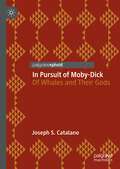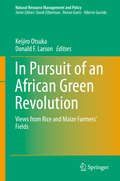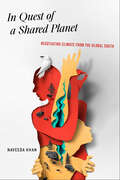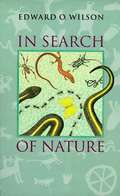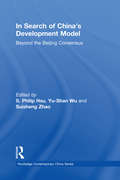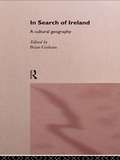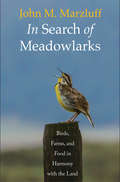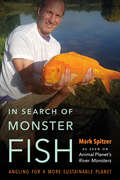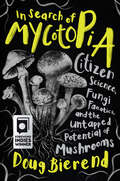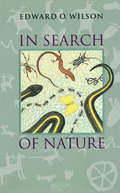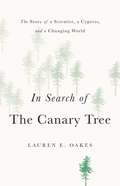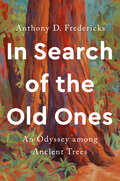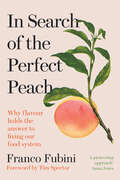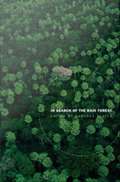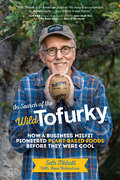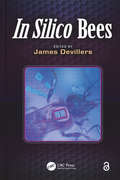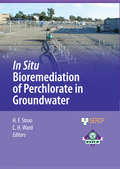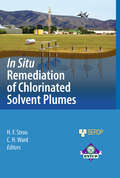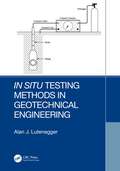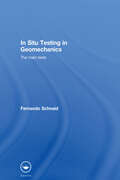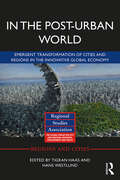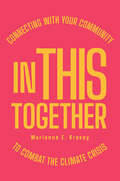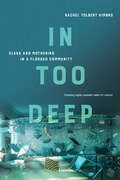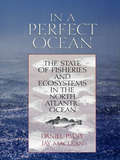- Table View
- List View
In Pursuit of Moby-Dick: Of Whales and Their Gods
by Joseph S. CatalanoThis study presents Moby-Dick as a novel with three distinct but interconnecting stories: Ishmael’s, which he shares ten years after it has taken place; Ahab’s, which is Ishmael's account of the memorable captain of a whaling ship; and a third which centres on whales and whaling, which has not received significant critical attention. While each of these perspectives compete for prominence in the narrative, Ahab and Ishmael's stories have often distracted from the vital significance of the whaling narrative as what outlasts Ahab’s obsessive mission. Catalano rights this wrong by coming to a strikingly original and thought-provoking conclusion which becomes the heart of the book's argument: “the unity of Melville’s book comes, first, from the way the numerous literary, philosophical, and religious reflections are rooted in those magnificent beings, whales and in the men and ships that pursue them, and, second, in the way these reflections illuminate our own lives.”
In Pursuit of an African Green Revolution
by Keijiro Otsuka Donald F. LarsonThis book explores recent experiences in the effort to bring about a Green Revolution in Sub-Saharan Africa (SSA). The chapters focus on rice and maize, which are promising and strategic smallholder crops. Significantly, we find that an African Rice Revolution has already begun in many irrigated areas, using Asian-type modern varieties, chemical fertilizer, and improved management practices. Further, we find that the same technological package significantly increases the productivity and profitability of rice farming in rainfed areas as well. We also find evidence that that management training, when done well, can boost productivity on smallholder farms. This suggests that African governments can accelerate the pace of Africa's Rice Revolution by strengthening extension capacity. The story for maize is wholly different, where most farmers use local varieties, apply little chemical fertilizer, and obtain very low yields. However, in the highly populated highlands of Kenya, a number of farmers have adopted high-yielding hybrid maize varieties and chemical fertilizer, as was the case in the Asian Green Revolution, apply manure produced by stall-fed cows, as was the case during the British Agricultural Revolution, and keep improved cows or cross-breeds from European cows and local stock, as was the case of the Indian White Revolution. We conclude that while rice in Africa has benefited from an Asian Green Revolution strategy that emphasizes modern seeds, inputs, and focused knowledge transfers, the success of Africa's Maize Revolution will require a different system approach based on hybrid maize, chemical and organic fertilizers, and stall-fed cross-bred cows.
In Quest of a Shared Planet: Negotiating Climate from the Global South
by Naveeda KhanBased on the author’s eight years of fieldwork with the United Nations-led Conference of Parties (COP), In Quest of a Shared Planet offers an illuminating first-person ethnographic perspective on climate change negotiations. Focusing on the Paris Agreement, anthropologist Naveeda Khan introduces readers to the only existing global approach to the problem of climate change, one that took nearly thirty years to be collectively agreed upon. She shares her detailed descriptions of COP21 to COP25 and growing understanding of the intricacies of the climate negotiation process, leading her to ask why countries of the Global South invested in this slow-moving process and to explore how they have maneuvered it.With a focus on the Bangladeshi delegation at the COPs, Khan draws out what it means to be a small, poor, and dependent country within the negotiation process. Her interviews with negotiators within country delegations uncover their pathways to the negotiating tables. Through observations of training sessions of negotiators of the Global South, Khan seeks to reveal understandings of what is or is not achievable within negotiated texts and the power of deal-making and deferrals. She profiles individuals who had committed themselves to the climate negotiation process, moving between the Secretariat, Parties, activists, and the wider UN system to bring their principles, strategies, emotions, and visions into view. She explores how the newest pillar of climate action, loss and damage, emerged historically and how developed countries attempted to control it in the process. Khan suggests that we understand the Global South’s pursuit of loss and damage not only as a politics of forcing the issue of a conjoined future upon the Global North, but as a gift to the youth of the world to secure that future.With this book Khan hopes to rekindle an older way of doing politics through the tenets of diplomacy upheld by the UN that have been overshadowed of late by the politics of confrontation. She stresses that while the tension between efforts of equity and solidarity and global economic competition, which have run through the negotiation process, might undercut the urgency to carry out climate mitigation, it needs to be addressed for meaningful and sustainable climate action.Deeply insightful and highly readable, In Quest of a Shared Planet is a stirring call to action that highlights the key role responsive and active youth have in climate negotiations. It is an invitation not only to understand the climate negotiation process, but also to navigate it (for those planning to attend sessions themselves) and to critique it—with, the author hopes, sympathy and an eye to viable alternatives.In Quest of a Shared Planet: Negotiating Climate from the Global South is available from the publisher on an open-access basis.
In Search Of Nature
by Edward O. WilsonDefinitely philisophical in nature. A scientist/philosophers view of life, nature etc. Not casual reading.
In Search of China's Development Model: Beyond the Beijing Consensus (Routledge Contemporary China Series)
by Yu-Shan Wu Suisheng Zhao S. Philip HsuThis book examines the development model that has driven China's economic success and looks at how it differs from the Washington Consensus. China’s Development Model (CDM) is examined with a view to answering a central question: given China’s peculiar matrix of a socialist party-state juxtaposed with economic internationalization and marketization, what are the underlying dynamics and the distinctive features of the economic and political/legal/social dimensions of the CDM, and how do we properly characterize their interrelations? The chapters further analyse to what extent and under what circumstances is China's development model sustainable, and to what degree is it readily applicable to other developing countries. Based on their findings in this volume, the authors conclude that the defining feature of the CDM’s economic dimension is "Janus-faced state-led growth," and the political/legal/social dimension of the CDM is best characterized as "adaptive post-totalitarianism." The contributors illustrate that the CDM’s parameters are shown to be much less sustainable than the CDM’s outcome in developmental performance and the extent to which the CDM can be applied to other late-developers is subject to more qualifications than its sustainability.
In Search of Ireland: A Cultural Geography
by Brian GrahamIn Search of Ireland argues that Ireland's political problems are created by conflicts and confusions of identity. It brings together a number of distinguished contributors, each of whom examines a particular aspect of Ireland's diverse cultural geography and history. Issues covered include: the changing definitions of Irishness the roles of class and gender in constructing traditional alignments of identity the role of ethnicity in Irish society the invention and imagining of Irish 'place' the political implications of a pluralistic Ireland The contributors demonstrate that many people both inside and outside of Ireland continue to define themselves and their conflicts through simple sectarian stereotypes. The authors argue that politicians and others must reject these outdated either/or representations and accommodate instead the fluidity of Irish identity. James Anderson, University of Newcastle-Upon-Tyne S.J. Connolly, Queens's University, Belfast Neville Douglas, Queen's University, Belfast Brian Graham, University of Ulste
In Search of Meadowlarks: Birds, Farms, and Food in Harmony with the Land
by John M. MarzluffAn ornithologist&’s personal look at farming practices that finds practical solutions for sustainable food production compatible with bird and wildlife conservation With predictions of a human population of more than nine billion by the middle of this century and eleven billion by 2100, we stand at a crossroads in our agricultural evolution. In this clear and engaging yet scientifically rigorous book, wildlife biologist John M. Marzluff takes a personal approach to sustainable agriculture. He travels to farms and ranches across North and Central America, including a Nebraska corn and soybean farm, California vineyards, cattle ranches in Montana, and small sustainable farms in Costa Rica, to understand the unique challenges and solutions to sustainable food production. Agriculture and wildlife can coexist, he argues, if farmers are justly rewarded for conservation; if future technological advancements increase food production and reduce food waste; and if consumers cut back on meat consumption. Beginning with a look backwards at our evolutionary history and concluding with practical solutions for change that will benefit farmers and ranchers, Marzluff provides an accessible and insightful study for the ecologically minded citizen, farmer, rancher, or conservationist.
In Search of Monster Fish: Angling for a More Sustainable Planet
by Mark SpitzerIn Search of Monster Fish is an action-packed, knee-slapping ride into and out of the belly of the beast. Join extreme angler Mark Spitzer as he encounters man-eating catfish, ruthless barracuda, lacerating conger eels, berserk tarpon, and blood-curdling sharks in locales as exotic as the Amazon, Catalonia, the Dominican Republic, Senegal, and even in our own backyards. But this eco-odyssey isn’t just about meeting and releasing some of the most grotesque lunkers in the world. It’s about implementing solutions for problems as behemoth as global warming and issues as common as choosing what to eat for dinner. And as the ice caps melt at the rate of 1 percent annually, Spitzer battles his most epic goliath: a leviathan that dwells in the depths of us all, making us ask who the real monsters are, what our responsibilities truly are, and what we can possibly do to sustain our planet and ourselves when faced with such demonic disenlightenment. Spitzer then beats this whopper into submission by reframing his call to action and finding his own way. A new portal to the underworld has been opened in the cutting-edge literature of monster fish, and this is your entry ticket.
In Search of Mycotopia: Citizen Science, Fungi Fanatics, and the Untapped Potential of Mushrooms
by Doug Bierend&“Mushrooms are having a moment. [A] natural sequel for the many readers who enjoyed Merlin Sheldrake&’s Entangled Life.&”—Library Journal&“Bierend writes with sensual verve and specificity, enthusiasm, and humor. . . . [He] introduces us to the staggering variety of mushrooms, their mystery, their funk, and the way they captivate our imaginations.&”—The Boston Globe&“Nothing is impossible if you bring mushrooms into your life, and reading this book is a great way to begin your journey.&”—Tradd Cotter, author of Organic Mushroom Farming and MycoremediationFrom ecology to fermentation, in pop culture and in medicine—mushrooms are everywhere. With an explorer&’s eye, author Doug Bierend guides readers through the weird, wonderful world of fungi and the amazing mycological movement.In Search of Mycotopia introduces us to an incredible, essential, and oft-overlooked kingdom of life—fungi—and all the potential it holds for our future, through the work and research being done by an unforgettable community of mushroom-mad citizen scientists and microbe devotees. This entertaining and mind-expanding book will captivate readers who are curious about the hidden worlds and networks that make up our planet.Bierend uncovers a vanguard of mycologists: growers, independent researchers, ecologists, entrepreneurs, and amateur enthusiasts exploring and advocating for fungi&’s capacity to improve and heal. From decontaminating landscapes and waterways to achieving food security, In Search of Mycotopia demonstrates how humans can work with fungi to better live with nature—and with one another.&“Comprehensive and enthusiastic. . . . This fascinating, informative look into a unique subculture and the fungi at its center is a real treat.&”—Publishers Weekly&“If you enjoyed Merlin Sheldrake&’s Entangled Life . . . I highly recommend this book. . . . In the vein of Louis Theroux, Bierend journeys deep in the wonderfully strange subculture of the mushroom-mad.&”—Idler magazine&“Engaging and entertaining. . . .Bierend proves his skill as a science journalist through interviews and experiences shared with mushroom experts and citizen scientists.&”—Choice
In Search of Nature: Competition, Citizen Action, And Clean Power
by Edward O. Wilson Laura SouthworthPerhaps more than any other scientist of our century, Edward O. Wilson has scrutinized animals in their natural settings, tweezing out the dynamics of their social organization, their relationship with their environments, and their behavior, not only for what it tells us about the animals themselves, but for what it can tell us about human nature. He has brought the fascinating and sometimes surprising results of these studies to general readers through a remarkable collection of books, including The Diversity of Life, The Ants, On Human Nature, and Sociobiology. The grace and precision with which he writes of seemingly complex topics has earned him two Pulitzer prizes, and the admiration of scientists and general readers around the world.In Search of Nature presents for the first time a collection of Edward O. Wilson's seminal short writings, addressing in brief and eminently readable form the themes that have actively engaged this remarkable intellect throughout his career. The essays' central theme is that wild nature and human nature are closely interwoven, and, not without optimism, Wilson concludes that we are smart enough and have time enough to avoid an environmental catastrophe of civilization-threatening dimensions if we are willing both to redirect our science and technology, and reconsider our self-image as a species.From "the little things that run the world"-- invertebrate species that make life possible for everyone and everything -- to many scientists' emergent belief in the human species' innate affinity for other living things, known as biophilia, Wilson sets forth clear and compelling reasons why humans should concern themselves with species loss.In Search of Nature is a lively and accessible introduction to the writings of one of the most brilliant scientists of the 20th century. Imaginatively illustrated by noted artist Laura Southworth, it is a book all readers will treasure.
In Search of the Canary Tree: The Story of a Scientist, a Cypress, and a Changing World
by Lauren E. OakesThe surprisingly hopeful story of one woman's search for resiliency in a warming worldSeveral years ago, ecologist Lauren E. Oakes set out from California for Alaska's old-growth forests to hunt for a dying tree: the yellow-cedar. With climate change as the culprit, the death of this species meant loss for many Alaskans. Oakes and her research team wanted to chronicle how plants and people could cope with their rapidly changing world. Amidst the standing dead, she discovered the resiliency of forgotten forests, flourishing again in the wake of destruction, and a diverse community of people who persevered to create new relationships with the emerging environment. Eloquent, insightful, and deeply heartening, In Search of the Canary Tree is a case for hope in a warming world.
In Search of the Old Ones: An Odyssey among Ancient Trees
by Anthony D. FredericksAn extraordinary journey to visit the oldest trees in the United States that beautifully reveals the connection between humans and natural history— a perfect read for nature lovers and fans of The Hidden Life of Trees.Follow award-winning author Anthony D. Fredericks's adventures across the United States to uncover the remarkable secrets and lives of ancient trees. He introduces some of the oldest trees in the country using up-to-date research, interviews with scientists, captivating storytelling, and a contagious wonder for the natural world. Fredericks's visits to the trees turn readers into fellow travelers. Through firsthand accounts and scientific detail, these enduring trees come to life off the page.Each chapter begins with a time-travel story that immerses readers in Earth's past, as early as ~58,000 BCE, for a sweeping view of what was happening during human history when the ancient tree took root. It then zooms into present-day to investigate the tree in all its mature glory and the changed world around it.Some of the featured trees include: A 13,000-year-old Palmer's oak in California that survives by cloning itselfThe 1,200-year-old Seven Sisters Oak in Louisiana that has survived in the path of at least ten major hurricanes2,000-year-old redwoods (the tallest trees in the world) on the California coastThe 2,628 year old bald cypress in the Black River of North CarolinaMarvelously detailed and deeply passionate, In Search of the Old Ones will transform your perspective of the trees and forests around you.
In Search of the Perfect Peach: Why flavour holds the answer to fixing our food system
by Franco FubiniWITH A FOREWORD FROM TIM SPECTOR, author of The Diet Myth, Spoon-Fed and Food for Life ‘This book is a passionate rallying call for a change of mindset…’ Mail on Sunday "A pioneering approach."—Anna Jones, cook and bestselling author of Easy Wins "By valuing and reclaiming flavour, Franco argues that we can transform the system and also enrich our relationship with food. Essential reading."—Dan Saladino, journalist, broadcaster and author of Eating to Extinction Let flavour guide our food choices – and lead us to a better food future. In Search of the Perfect Peach shows us how this simple desire can bring about a healthier, tastier and brighter future for our food, the people who produce it and the soil it grows in. That first bite of a perfectly ripe peach can be truly transformative – a joyful moment that will stay with you forever. For Franco Fubini, founder and CEO of Natoora, this encounter also leads him to realise that flavour is not simply a fleeting, visceral experience but a window into the farmer, a connection to our natural environment and a taste test for our food system. What makes a great-tasting tomato? Why is scarring on a greengage a good sign? Does ‘eating local’ narrow our priorities to the exclusion of others? In Search of the Perfect Peach follows Franco as he navigates the food system in pursuit of this elusive element. As he takes us from Sicily’s citrus groves to the streets of Mexico City, he shows how we have allowed the wider industry to compromise on more than just flavour. Franco’s search for the Greta peach culminates in his own clarity and conviction: by looking to flavour, we can unpick the industrialisation of our food production, restore nutrition and seasonal diversity to our plates and the craft of growing back to our landscapes. And, above all, we can find that perfect peach every summer. "This exciting and important book now brings Natoora and all its ingredients not just to restaurants like ours but … to everyone’s home."—Ruth Rogers, chef and co-founder of The River Cafe "An incredible read for those who love food and care about its future. In Search of the Perfect Peach is both a love story and technical guide."—Kyle Connaughton, chef and owner of SingleThread Farm, Restaurant and Inn
In Search of the Rain Forest
by Candace SlaterThe essays collected here offer important new reflections on the multiple images of and rhetoric surrounding the rain forest. The slogan "Save the Rain Forest!"--emblazoned on glossy posters of tall trees wreathed in vines and studded with monkeys and parrots--promotes the popular image of a marvelously wild and vulnerable rain forest. Although representations like these have fueled laudable rescue efforts, in many ways they have done more harm than good, as these essays show. Such icons tend to conceal both the biological variety of rain forests and the diversity of their human inhabitants. They also frequently obscure the specific local and global interactions that are as much a part of today's rain forests as are the array of plants and animals. In attending to these complexities, this volume focuses on specific portrayals of rain forests and the consequences of these characterizations for both forest inhabitants and outsiders. From diverse disciplines--history, archaeology, sociology, literature, law, and cultural anthropology--the contributors provide case studies from Latin America, Asia, and Africa. They point the way toward a search for a rain forest that is both a natural entity and a social history, an inhabited place and a shifting set of ideas. The essayists demonstrate how the single image of a wild and yet fragile forest became fixed in the popular mind in the late twentieth century, thereby influencing the policies of corporations, environmental groups, and governments. Such simplistic conceptions, In Search of the Rain Forest shows, might lead companies to tout their "green" technologies even as they try to downplay the dissenting voices of native populations. Or they might cause a government to create a tiger reserve that displaces peaceful peasants while opening the doors to poachers and bandits. By encouraging a nuanced understanding of distinctive, constantly evolving forests with different social and natural histories, this volume provides an important impetus for protection efforts that take into account the rain forest in all of its complexity. Contributors. Scott Fedick, Alex Greene, Paul Greenough, Nancy Peluso, Suzana Sawyer, Candace Slater, Charles Zerner
In Search of the Wild Tofurky: How a Business Misfit Pioneered Plant-Based Foods Before They Were Cool
by Steve Richardson Seth TibbottThe founder of Tofurky reveals how an idealistic hippie living in a treehouse created a global brand—and sold millions of products without selling out. In this entertaining memoir, Seth Tibbott reveals how he achieved overnight success—but only after fifteen years of intrepid failure. He tells the triumphant tale of how a self-described hippie with no business training but plenty of enterprising goals grew a $2,500 startup into a global brand and ushered in a plant-based foods renaissance along the way. Tibbott took home a grand total of $31,000 in his first nine years of striving to bring to the people a nearly unknown soy product—tempeh—he knew in his gut was revolutionarily tasty. He eschewed a buttoned-up lifestyle and resided in tipis, trailers, and a treehouse; rented workspace to piano-repairing circus clowns; and even briefly counted the infamous Rajneeshees as clients. Tibbott was never one to chase the money or try to fit in. Instead, he built a business that fit him. Thus Tibbott discovered the &“secret sauce&” ingredients that took his now-international brand from fameless to fame-ish to famous: bootstrapping, building business intuition, and staying true to his belief in eco-friendly practices. In Search of the Wild Tofurky proves that a good idea can change the world and make money, no matter the naysayers or the sometimes-harsh twists and turns of the unconventional path. &“Expert advice and inspiration from a most unconventional source . . . An education in the business of ethics.&” ―Eric C Lindstrom, author of The Skeptical Vegan
In Silico Bees
by James DevillersBees are critically important for ecosystem function and biodiversity maintenance through their pollinating activity. This book provides a collection of computational methods to those primarily interested in the study of the ecology, ethology, and ecotoxicology of bees. It presents numerous case studies to enable readers to understand the appropriateness but also the limitations of models in theoretical and applied bee research. Written by an international team of experts, this book covers the main types of modeling approaches that can be used in terrestrial ecology and applied ecotoxicology.
In Situ Bioremediation of Perchlorate in Groundwater
by C. Herb Ward Hans F. StrooThis volume presents a critical analysis and timely synthesis of the past decade of intensive research, development, and demonstrations on the in situ bioremediation of perchlorate in groundwater. The intended audiences include the decision makers, practicing engineers and hydrogeologists who will select, design, and operate these remedial systems, as well as researchers seeking to improve the current state-of-the-art. Our hope is that this volume will serve as a useful resource to assist remediation professionals in applying and developing the technology as effectively as possible. An overview of the current state-of-understanding of perchlorate remediation is followed by a discussion of basic principles of microbial and abiotic processes, and of the engineering and implementation issues underlying the technologies described. Characterization of both anthropogenic and natural sources of perchlorate, including isotopic analysis to distinguish between differing sources, precedes discussions of the advantages, performance, and relative costs of applying a range of remedial technologies. Active, semi-passive, and passive in situ bioremediation are fully described and compared with emphasis on field application. Cost information for each technology, using case studies and analyses of several template sites, covers capital costs, as well as costs for laboratory testing, pilot-scale demonstration, design, system operation, monitoring and maintenance during operations, and demolition and restoration after remediation. In addition, analogous cost data are presented for pump-and-treat systems for each template site to illustrate the potential cost savings associated with the use of alternative approaches. Emerging technologies such as monitored natural attenuation, phytoremediation, and vadose zone bioremediation are described, and field demonstrations are used to illustrate the current stage of maturity and the potential applicability of these approaches for specific situations.Each chapter in this volume has been thoroughly reviewed for technical content by one or more experts in each subject area covered.
In Situ Chemical Oxidation for Groundwater Remediation
by Robert L. Siegrist Michelle Crimi Thomas J. SimpkinThis volume provides comprehensive up-to-date descriptions of the principles and practices of in situ chemical oxidation (ISCO) for groundwater remediation based on a decade of intensive research, development, and demonstrations, and lessons learned from commercial field applications.
In Situ Remediation of Chlorinated Solvent Plumes
by C. Herb Ward Hans F. StrooThis volume provides a review of the past 10 to 15 years of intensive research, development and demonstrations on the in situ remediation of dissolved chlorinated solvents. The intended audience includes the decision makers and practicing engineers and hydrogeologists who will select, design and operate these remedial systems, as well as researchers seeking to improve the current state-of-the-art. Our hope is that this volume will serve as a useful resource to assist remediation professionals in applying and developing the technology as effectively as possible.
In Situ Testing Methods in Geotechnical Engineering
by Alan J. LuteneggerIn Situ Testing Methods in Geotechnical Engineering covers the field of applied geotechnical engineering related to the use of in situ testing of soils to determine soil properties and parameters for geotechnical design. It provides an overview of the practical aspects of the most routine and common test methods, as well as test methods that engineers may wish to include on specific projects. It is suited for a graduate-level course on field testing of soils and will also aid practicing engineers. Test procedures for determining in situ lateral stress, strength, and stiffness properties of soils are examined, as is the determination of stress history and rate of consolidation. Readers will be introduced to various approaches to geotechnical design of shallow and deep foundations using in situ tests. Importantly, the text discusses the potential advantages and disadvantages of using in situ tests.
In Situ Testing in Geomechanics: The Main Tests
by Fernando SchnaidThis book outlines the practice and theory of the five key tests used in site characterisation by Geomechanical and Environmental Engineers. These tests are: Standard Penetration Tests, Cone Penetration Tests, Vane Test, Pressuremeter Tests, Dilatometer Tests. This book is aimed at practising engineers although its practical angle will also appeal to Civil Engineering students in their 3rd and 4th years.
In The Post-Urban World: Emergent Transformation of Cities and Regions in the Innovative Global Economy (Regions and Cities)
by Hans Westlund Tigran HaasWinner of the Regional Studies Association's Best Book Award 2018. In the last few decades, many global cities and towns have experienced unprecedented economic, social, and spatial structural change. Today, we find ourselves at the juncture between entering a post-urban and a post-political world, both presenting new challenges to our metropolitan regions, municipalities, and cities. Many megacities, declining regions and towns are experiencing an increase in the number of complex problems regarding internal relationships, governance, and external connections. In particular, a growing disparity exists between citizens that are socially excluded within declining physical and economic realms and those situated in thriving geographic areas. This book conveys how forces of structural change shape the urban landscape. In The Post-Urban World is divided into three main sections: Spatial Transformations and the New Geography of Cities and Regions; Urbanization, Knowledge Economies, and Social Structuration; and New Cultures in a Post-Political and Post-Resilient World. One important subject covered in this book, in addition to the spatial and economic forces that shape our regions, cities, and neighbourhoods, is the social, cultural, ecological, and psychological aspects which are also critically involved. Additionally, the urban transformation occurring throughout cities is thoroughly discussed. Written by today’s leading experts in urban studies, this book discusses subjects from different theoretical standpoints, as well as various methodological approaches and perspectives; this is alongside the challenges and new solutions for cities and regions in an interconnected world of global economies. This book is aimed at both academic researchers interested in regional development, economic geography and urban studies, as well as practitioners and policy makers in urban development.
In This Together: Connecting with Your Community to Combat the Climate Crisis
by Marianne E. KrasnyIn This Together explores how we can harness our social networks to make a real impact fighting the climate crisis. Against notions of the lone environmental crusader, Marianne E. Krasny shows us the power of "network climate action"—the idea that our own ordinary acts can influence and inspire those close to us. Through this spread of climate-conscious practices, our individual actions become collective ones that can eventually effect widespread change.Weaving examples of everyday climate-forward initiatives in with insights on behavioral and structural change, Krasny demonstrates how we can scale up the impact of our efforts through leveraging our community connections. Whether by inviting family, friends, or colleagues to a plant-rich meal or by becoming activists at climate nonprofits, we can forge the social norms and shared identities that can lead to change. With easy-to-follow dos and don'ts, In This Together shows us a practical and hopeful way forward into our shared future.
In Too Deep: Class and Mothering in a Flooded Community
by Rachel KimbroIn a small Texas neighborhood, an affluent group of mothers has been repeatedly rocked by catastrophic flooding—the 2015 Memorial Day flood, the 2016 Tax Day flood, and sixteen months later, Hurricane Harvey. Yet even after these disrupting events, almost all mothers in this neighborhood still believe there is only one place for them to live: Bayou Oaks.In Too Deep is a sociological exploration of what happens when climate change threatens the carefully curated family life of upper-middle-class mothers. Through in-depth interviews with thirty-six Bayou Oaks mothers whose homes flooded during Hurricane Harvey, Rachel Kimbro reveals why these mothers continued to stay in a place that was becoming more and more unstable. Rather than retreating, the mothers dug in and sustained the community they have chosen and nurtured, trying to keep social, emotional, and economic instability at bay. In Too Deep provides a glimpse into how class and place intersect in an unstable physical environment and underlines the price families pay for securing their futures.
In a Perfect Ocean: The State Of Fisheries And Ecosystems In The North Atlantic Ocean (The State of the World's Oceans #1)
by Jay Maclean Daniel PaulyRecent decades have been marked by the decline or collapse of one fishery after another around the world, from swordfish in the North Atlantic to orange roughy in the South Pacific. While the effects of a collapse on local economies and fishing-dependent communities have generated much discussion, little attention has been paid to its impacts on the overall health of the ocean's ecosystems.In a Perfect Ocean: The State of Fisheries and Ecosystems in the North Atlantic Ocean presents the first empirical assessment of the status of ecosystems in the North Atlantic ocean. Drawing on a wide range of studies including original research conducted for this volume, the authors analyze 14 large marine ecosystems to provide an indisputable picture of an ocean whose ecology has been dramatically altered, resulting in a phenomenon described by the authors as "fishing down the food web." The book provides a snapshot of the past health of the North Atlantic and compares it to its present status; presents a rigorous scientific assessment based on key criteria; considers the factors that have led to the current situation; describes the policy options available for halting the decline; and offers recommendations for restoring the North Atlantic. This is the first in a series of assessments by the world's leading marine scientists, entitled "The State of the World's Oceans." In a Perfect Ocean: The State of Fisheries and Ecosystems in the North Atlantic Ocean is a landmark study, the first of its kind to make a comprehensive, ecosystem-based assessment of the North Atlantic Ocean, and will be essential reading for policymakers at the state, national, and international level concerned with fisheries management, as well for scientists, researchers, and activists concerned with marine issues or fishing and the fisheries industry.
